1915
|
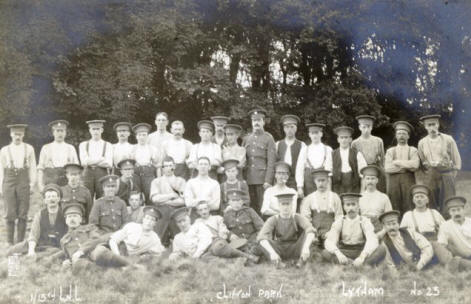
13th Loyal North Lancashire at 'Clifton Park' (probably Lytham Hall Park), 1915.
|
151st & 148th RFA Brigades at Lytham.

RFA Brigades on parade, Lytham Green, April, 1915.
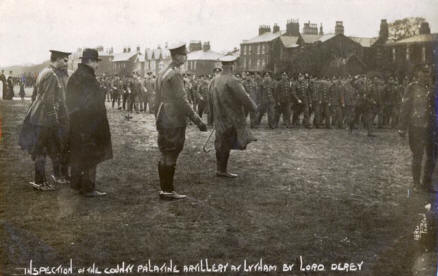
Lord Derby inspecting the 151st & 148th RFA Brigades on Lytham
Green, 16 April 1915.
|
WOMAN'S TWO SOLDIER HUSBANDS
At the Old Bailey, on Wednesday, Phyllis Ayris (26), was sentenced to six
months' hard labour for bigamy. Prosecuting counsel said that prisoner was married in December,
1910, at Manchester, her husband being a London Territorial, who last year went to the front, was
wounded, and was discharged as unfit. He allowed her 28s. a week. Prisoner "married" a young
Canadian soldier in London while her husband was away, and he assigned her 25s. a week. The
Recorder, Sir Forrest Fulton, said that prisoner had found herself in clover through the
war.
Some people were making a very good thing out of the war, and she was one
of them. In addition to bigamy, she had falsified the register by giving a false name and
describing "herself as a spinster. Substantial punishment must be meted out in cases of bigamy,
which were part of a regular scheme to defraud the unfortunate taxpayers.
SOLDIER'S ATTEMPTED SUICIDE.
John Shea, a private-in the 3/5th King's Liverpool Regt., billeted at
Blackpool, was charged at Blackpool Court, with attempting to commit suicide. The Chief Constable
said that on Wednesday morning Shea went into his billet, in Kirkby Road, and later he was found in
his bedroom with a belt wrapped tightly round his neck.
It was unbuckled, and P.S. Hill called in. The man had been
in the Army about six weeks, and prior to enlisting he had been on board a ship that had been,
torpedoed, and had his nerves upset. His officers were present in Court, and were prepared to take
charge of him, and place him under their own medical officer. Shea was
discharged.
|
|
May 1915
UNREGISTERED ALIEN AT ST. ANNES.
DUTCHMAN FINED.
At Lytham Police Court, on Tuesday, Cornelies William Nieuwerf, a Dutchman, and
who said he had lived in England for 36 years, was charged as an alien residing in a prohibited
area, St. Annes, and with failing to register, as required by the Registration of Aliens
(Restriction) Order, 1914.
Defendant pleaded ignorance of the law’s requirements, and said he registered at
Birkenhead in November last, and was there told he could go where he liked as a friendly alien.
Defendant was fined 20s.
Mr.S.L.Stott, the chairman, said the Bench hoped the case would be a warning to
others because if further cases came up they would deal much more severely with them.
|
|
ST. ANNES HERO.
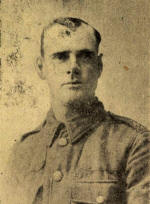
Corpl. Harold Law, 2nd Shropshire
Light Infantry, of 7, Glen Eldon Road, St.Annes who was killed in action on May 9th. He served
through the South African War, and was wounded last March. On recovery he was sent back to the
trenches.
|
|
June 1915
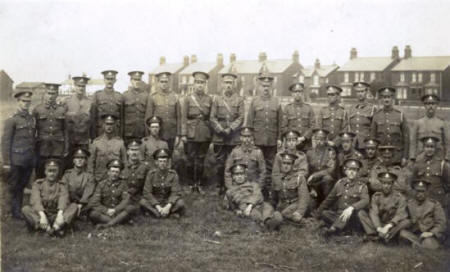
Soldiers of the Royal Field Artillery in fields off Headroomgate Road, June, 1915 (Houses
in the background are on Highbury Road).
|
|
June 1915
NATIONAL MOTOR
VOLUNTEERS.
HELPING RECRUITING.
The No. 1 Platoon of
the St. Annes Corps of the N.M.V. have been hard at practical work this week, and since last
Saturday have been assisting the recruiting efforts made in the Fylde district. On Monday last
the St. Annes Corps turned out and assembled in the Square, some 20 cars being the average for
three successive days.
On Tuesday the N.M.V.
cars conveyed Lord Derby's band to the outlying districts, some proceeding to Kirkham,
Woodplumpton, Broughton, Brock, Treales to Lytham, and others taking the bandsmen to Longridge,
Freckleton, Poulton, etc. On Wednesday similar districts were worked. The members were cordially
thanked by the recruiting officers for the service. To those ladies and gentlemen who lent their
cars to the N.M.V. Corps, the secretary tenders best thanks.
|
|
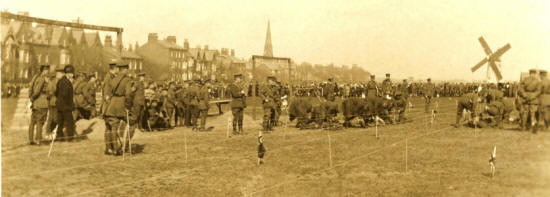
The last of the RFA Brigades
left the area in August 1915. Lytham was used to billet and train soldiers from the Pioneer
Battalions. They are seen here training on Lytham Green.
|
December 1915
Pte. Graham
Reece.
A fortnight ago
word came to Lytham casually that this soldier had been killed, but as he had warned his wife not
to listen to rumours, she hoped on until Wednesday morning, when the official intimation came that
he had died from exposure at the Dardanelles He had been very ill, was afterwards better, and then
worse again.
He was well-known
as the left-handed bacon cutter at Seymour Mead's, before the introduction of machinery, and was
always very courteous to customers.
He married tthe
maid at Mr. J. W. Hall's, Church Road, where she is still in service, and joined Kitchener's Army
at the first recruiting meeting in the Pier Pavilion last year, being subsequently drafted to the
King's Own Lancaster Regiment, and sent out to Gallipoli. He was 29 years of age.
|
Mr Sam Wilson's Seven Sons
NOW ON ACTIVE SERVICE
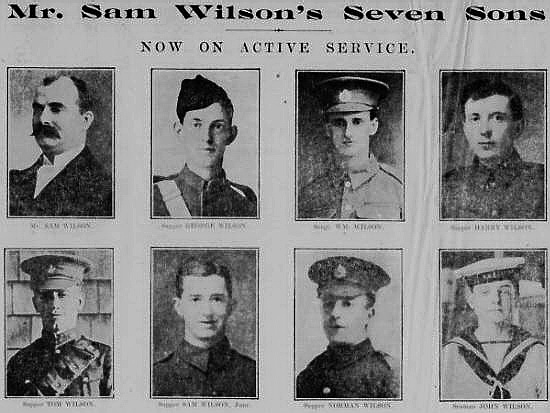
Sam Wilson whose whole family of seven sons were on active service in 1915.
Mr. Sam Wilson, who was one of the best known men in St. Annes, prior to his
removal to Blackpool a few years ago, has a family of which he has just reason to be proud. His
whole family of seven sons are on active service, and the fact is doubly interesting to St. Annes
because of the fact that they are all natives of St. Annes.
Mr. Wilson was, for quarter of a century, in business in an ironmonger's shop in
St. Andrew's Road South, but was best known as a builder and contractor. He erected much
residential property and the Carnegie Library at St. Annes, and he also built the Workhouse at
Wesham. His workshop was behind West Crescent, St Annes and is now used by the Volunteer
Training Corps as headquarters.
Although only 55 years of age, Mr. Wilson had a long connection with the 2nd
Manchester Volunteers, retiring with the rank of sergeant and the long service Medal. Six of Mr.
Wilson’s sons are in the Army—all in the Royal Engineers—and one in the Navy. The second son,
Sergt. W. Wilson, lives in Kilnhouse Lane, St. Annes.
Two sons—George and William—are in the Dardanelles campaign, and the other
two—Harry and Tom—were in Canada when war broke out, but they enlisted in the first Canadian
contingent and are now in France.
Sam, junr., is in France, and Norman is in training with the West Lancashire
Territorial Engineers. The youngest, John, is on H.M.S. "Temeraire." All the seven took much
interest in St. Anne’s football, and Tom and Sam played for St. Annes Corinthians. The photographs
are placed in order according to age.
Blackpool Herald, December 1915
|
Some of the soldiers from St Annes on Sea, killed in action 1914
& 1915.
|
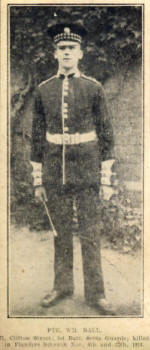
Private William Ball, 71 Clifton Street (now Curzon Road) 1st Battalion Scots
Guards. Killed in Flanders between 4 & 12 November 1914
|
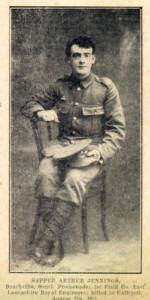
Sapper Arthur Jennings, Beachville, South
Promenade; 1st Field Company., Lancashire Royal Engineers; killed in Gallipoli
August 7th 1915.
|
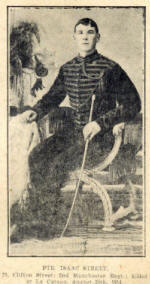
Private Isaac Street, 2nd Manchester Regt Killed at La Cateau,
August 26 1914.
|
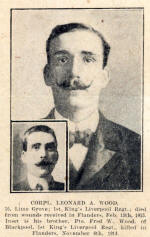
Corporal Leonard A Wood, 16, Lime Grove; 1st King's Liverpool
Regiment; died from wounds received in Flanders February 15th 1915. Inset is his
brother Private Fred W Wood of Blackpool, 1st King's Liverpool Regiment killed in
Flanders, November 4th 1914.
|
|
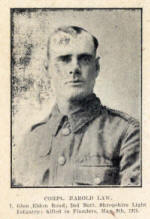
Corporal Harold Law, 7, Glen
Eldon Road; 2nd Battalion Shropshire Light Infantry; killed in Flanders, May 9th
1915.
|
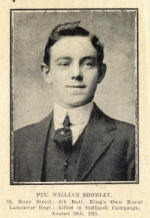
Private William Bromley, 18
Hope Street; 6th Battalion King's Own Royal Lancaster Regiment; killed in Gallipoli
August 10th 1915.
|
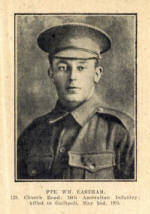
Private William Eastham, 16th Australian Infantry; killed in
Gallipoli May 2nd 1915.
|
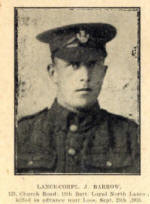
Lance Corporal J Barrow, 129
Church Road; 11th Battalion, Loyal North Lancashire Regiment; killed in advance
near Loos, September 25th 1915.
|
|
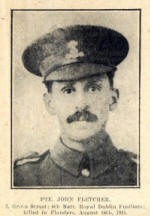
Private John Fletcher, 2 Grove Street; 6th
Battalion Royal Dublin Fusiliers; killed in Flanders August 16th
1915
|
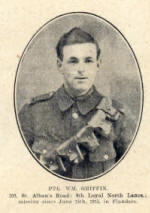
Private William Griffin, 109 St.Alban's Road;
4th Loyal North Lancashire Regiment; missing since June15th 1915, in
Flanders.
|
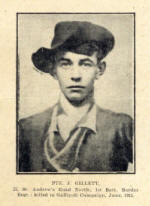
Private J Gillett, 33
St.Andrew's Road North; 1st Battalion Border Regiment; killed in Gallipoli
Campaign, June 1915.
|
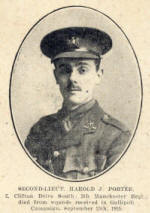
Second-Lieutenant Harold J
Porter, 2 Clifton Drive South; 5th Manchester Regiment; killed in
Gallipoli Campaign, September 15th 1915.
|
|
|
Blackpool
Times December 1915
DEPARTURE OF
R.F.A.
GOOD WISHES FOR 150th BRIGADE.
The following
letters have been forwarded to Col. Dixon, commanding the 150th Brigade R.F.A. (Blackburn
Brigade), which was formerly stationed at St. Annes.
“The chairman and
members of the Blackburn Recruiting Committee desire, on the eve of your departure for active
ser ice to wish your officers, N.C.O.'s, and men in the Blackburn Brigade God speed.—
E. Hamer, Town Hall, Blackburn."
"I desire, on
behalf of the citizens of Blackburn, to convey to your officers, N.C.O.'s and men in the
Blackburn Brigade R.F.A., our good wishes and God speed on your departure for active
service.—Alfred Nuttall, Mayor."
|
Blackpool Herald,
December 1915
CHRISTMAS
TOYS.
ENGLISH INDUSTRY TREBLED.
Children's toys are as plentiful this season as ever.
Whilst those from Germany and Austria have disappeared, the toy industry in England has been
trebled to meet the demand, and French and Japan have sent us large numbers of dolls and
mechanical toys. A new doll, with real hair and a pleasant expression has been made by the
British Red Cross. It is called an "Unconscious Exerciser," its arms being made of spiral
springs, which expand and contract as the child uses them.
From Lord Roberts' Memorial workshops have come
battle toys and war games; and old-established firms, amongst other novelties, are filling snow
men and snowballs with toys and making "lucky pies" from which toys can be abstracted by means
of coloured tapes. The Japanese dolls are miniatures in dress and figure of the men and women of
our Far Eastern ally. English industries have put on the market a series of nursery rhyme dolls,
including Old Mother Hubbard and her dog, little Jack Horner and his pie, and little Miss Muffet
and her spider.
There are Teddy bears dressed as British officers,
Belgian soldiers and French infantrymen, and all the notable men of the war have been reproduced
as striking little figures standing 18in. high. Most of the large wooden toys, including
motor-cars with bicycle pedals, have been made in England. From English firms also have come
those large dolls' houses which are so conspicuous a feature of the great toy fair at
Harrod's.
Standing eight or nine feet high, children ran
open their doors and enter, go upstairs and find a room for their reception on the first floor.
All the Kindergarten toys puzzles, and bricks and cubes that used to come from Germany are now
made in England. Some of the British-made boxes of wooden blocks contain masts and sails and all
the necessary accessories for building yachts. Others have turrets, guns and flags, with
instructions for building warships and fitting with special keel which enables them to float
upright in water.
One of the new British-made toys is certain to have a
wide popularity with boys. It is the howitzer that fires a bursting shell. By means of a spring
the shell "explodes" harmlessly immediately it strikes the object. There are also boxes of
realistic models of guns, armoured trains and aeroplanes, torpedoes, soldiers in trenches, and
so on, showing how our battles are fought.
All these models fit into one another or stand firmly
by themselves, so that on a dining-room table a child may make with them a fine battle array.
Ireland, for the first time this year, has entered the domain of toys, and has sent across the
Channel boxes of standardised and interchangeable blocks for building wooden houses, churches,
castles, forts and bridges. There is, in fact, no end to the list of toys for Christmas. The
only perceptible change at the big fairs is the absence of some of the cheaper sixpenny and
shilling toys that used to be made in Germany. The English toy costs a little more, and is
infinitely stronger and better.
|
|